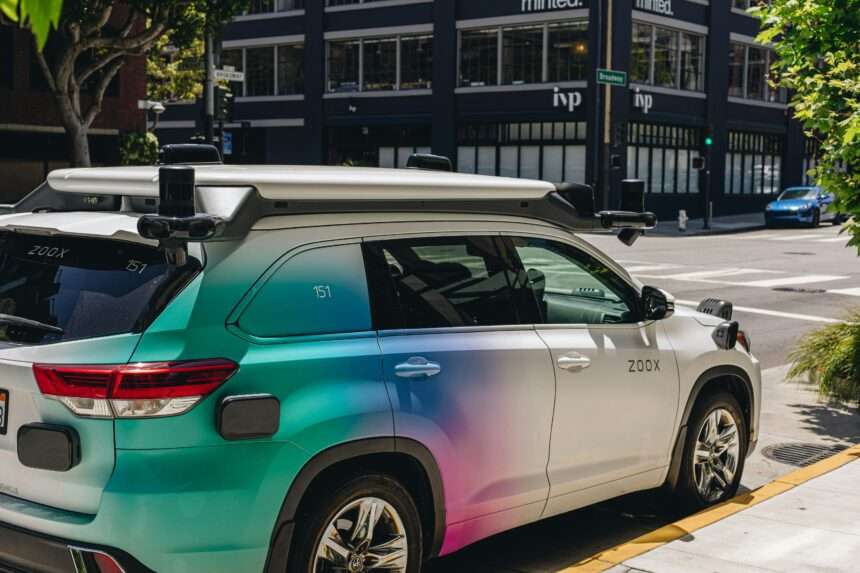On November 6th, 2025, something historic happened that most of the world barely noticed: two Chinese autonomous driving companies went public simultaneously on the Hong Kong Stock Exchange, marking the moment when self-driving technology moved from research and hype to mature, investor-backed business model.
- The Simultaneous Listings: Why Both Companies Went Public On The Same Day
- What These Companies Actually Do: The Real Business Model
- The Technology: Why Chinese Companies Are Leading
- The Market Opportunity: Why Investors Are Excited
- The Controversies: Disputes Over Permitting and Safety
- The Geopolitical Dimension: Chinese Tech Going Global
- The Path to Profitability: How These Companies Actually Become Valuable
- Stage 1: Achieve Per-Vehicle Breakeven (2025-2026)
- Stage 2: Rapid Fleet Expansion (2026-2028)
- Stage 3: Geographic Expansion (2028-2030)
- Stage 4: Profitability at Scale (2030+)
- Comparison: American Autonomous Driving vs. Chinese
- The Investment Thesis: Is This A Good Bet?
- What Happens Next
- Conclusion: The Moment Autonomous Driving Became Real
- External Resources & Sources
WeRide and Pony AI both launched their Hong Kong IPOs on the same morning, raising a combined $1.1 billion. These weren’t small placements. Pony AI’s $860 million offering marks the largest autonomous driving IPO globally in 2025. WeRide’s $308 million offering makes it the world’s first robotaxi company with dual primary listings (trading on both NASDAQ and Hong Kong).
But here’s what really matters: these companies aren’t going public because they’re speculative bets on future technology. They’re going public because they’re already operating. Already profitable on per-vehicle economics. Already scaling. The Hong Kong listings mark the moment when autonomous driving transitioned from “coming soon” to “already here.”
The Simultaneous Listings: Why Both Companies Went Public On The Same Day
The timing wasn’t coincidental. According to Car News China’s reporting, both companies coordinated their Hong Kong listings strategically. The simultaneous launch signals to international investors that Chinese autonomous driving isn’t a single-company story—it’s an industry phenomenon.
WeRide and Pony AI are fierce competitors. Yet they both agreed to list on Hong Kong on the same day. Why? Because the message is more powerful that way. A single company going public could be hype. Two leading competitors going public simultaneously? That’s validation that the market and technology are real.
The Financial Snapshot
According to CNBC’s market reporting:
- Pony AI: Raised HK$6.45 billion ($860 million) at HK$139 per share. Initial public offering was oversubscribed 15.88x—meaning demand was 16 times larger than available shares.
- WeRide: Raised HK$2.39 billion ($308 million) at HK$27.10 per share. IPO oversubscribed 73.44x—extraordinary demand showing how hungry investors are.
Both stocks fell on their first trading day (down 12-14%), which is normal for IPO volatility. But the massive oversubscription before trading even began shows institutional demand was enormous.
A Brief Reality Check: The Broader Context
This is remarkable in another way: these are unprofitable companies. According to China EV Home’s financial analysis, Pony AI’s net losses reached $154 million in 2024. WeRide lost $2.51 billion in 2024. Yet investors rushed to buy shares at IPO.
This reveals something important: investors aren’t betting on these companies ever being profitable. Investors are betting these technologies will be so transformative that scale matters more than current profitability.
What These Companies Actually Do: The Real Business Model
Before we understand why investors are excited, let’s be clear about what these companies actually operate.
Pony AI: The Robotaxi Leader
Pony AI currently operates over 720 active robotaxis in Chinese cities. According to company announcements, they’re planning to expand to 1,000 robotaxis by the end of 2025. These aren’t test vehicles—they’re revenue-generating. Passengers pay for rides in cities like Beijing, Guangzhou, and Shanghai.
The company expects to achieve per-vehicle breakeven in 2025. That’s critical. Once per-vehicle economics are positive, scaling becomes straightforward: add more vehicles, get more revenue. Profitability follows directly from scale.
According to 36Kr’s analysis, Pony AI’s robotaxi revenue in H1 2025 grew 178.8% year-over-year. The business is accelerating, not slowing.
Beyond robotaxis, Pony AI is also testing autonomous trucks with heavy-duty partners. If successful, this could represent an even larger market than passenger robotaxis.
WeRide: The Diversified Autonomous Vehicle Company
WeRide takes a broader approach. The company operates:
- Robotaxis: Similar to Pony AI, offering paid autonomous rides in Chinese cities
- Robobuses: Autonomous shuttle buses for public transit
- Robovans: Autonomous commercial vans for logistics and delivery
- Robosweepers: Autonomous street cleaning vehicles
- ADAS systems: Advanced driver assistance for traditional vehicles (Level 2/2+ capability)
According to Fortune’s interview with WeRide CEO Tony Han, the company is now operating in 30 cities across 11 countries, including international pilots in Singapore, France, Spain, Saudi Arabia, and the UAE.
The geographic diversity is strategic. While Pony AI focuses on China, WeRide is building a global footprint.
The Technology: Why Chinese Companies Are Leading
An obvious question: why are Chinese autonomous driving companies going public before American competitors like Waymo (Google’s autonomous vehicle division)? The answer reveals something important about technology development and regulation.
Regulatory Permissiveness in China
China has been far more permissive than the United States in allowing autonomous vehicles to operate publicly. Chinese regulators see autonomous driving as strategic technology and have authorized limited robotaxi services in several cities.
The U.S., by contrast, has been much more cautious. Waymo operates in limited cities with heavy restrictions. Cruise (GM’s autonomous vehicle division) had its operating permit suspended after safety incidents. The regulatory path to widespread deployment in America is much slower.
This regulatory advantage means Chinese companies are accumulating real-world data faster. More miles driven = more scenarios experienced = faster technology maturation.
The “World Model” Technology Edge
According to 36Kr’s technical analysis, Pony AI has developed something called the “World Model” (or PonyWorld)—a sophisticated simulation system that generates training data for autonomous driving algorithms.
The World Model works like this:
- Generate scenarios: Create infinite variations of real-world driving scenarios in simulation
- Train AI: Use simulated scenarios to train autonomous driving systems
- Real-world validation: Test trained models on actual roads
- Loop back: Feed real-world learnings back into simulation for better training
This closed-loop approach dramatically reduces the number of real-world test miles needed. Instead of driving millions of miles in the physical world, companies can train models in simulation first, then validate in the real world.
Interestingly, Tesla just announced a similar “World Simulator” project—showing that this approach is becoming industry standard.
The Market Opportunity: Why Investors Are Excited
The massive IPO oversubscription (73x for WeRide, 16x for Pony AI) reveals something about investor expectations. These companies are betting on a transformative market.
The Robotaxi Market Size
If autonomous vehicles truly replace human drivers for rideshare, the addressable market is enormous. The global rideshare market is worth hundreds of billions annually. Even a small percentage of that market becomes multibillion-dollar businesses.
More importantly, autonomous vehicles have dramatically better unit economics than human-driven rides. No driver salary. No driver benefits. Lower insurance (potentially). Lower operating costs across the board.
A robotaxi could theoretically cut the per-mile cost of rides by 40-60% compared to human drivers, while simultaneously improving safety and reliability.
The Logistics Market Size
Beyond passenger transportation, autonomous trucks represent an even larger opportunity. Long-haul trucking is expensive primarily because of driver costs. If autonomous trucks can reliably drive highways, the cost savings dwarf passenger robotaxis.
Pony AI’s investment in autonomous trucks signals belief that trucking might be the larger prize.
The Global Expansion Opportunity
WeRide’s presence in 30 cities across 11 countries shows the company is thinking globally. If autonomous driving technology works in one country, it can theoretically scale worldwide. Scale is everything in transportation.
Investors see this and extrapolate: if these companies can achieve global scale, they become trillion-dollar enterprises.
The Controversies: Disputes Over Permitting and Safety
Not everything about these IPOs was smooth. According to China EV Home’s reporting, WeRide’s CFO Li Xuan publicly accused Pony AI of misrepresenting its operational scope in investor materials. WeRide alleged that Pony AI downplayed the number of cities where WeRide operates, creating a false sense of competitive advantage.
Pony AI hasn’t responded to these allegations. The dispute highlights competitive tensions and the temptation to inflate capabilities when going public.
This is worth monitoring. If either company has misrepresented safety data or operational scope, it could trigger investor backlash and regulatory scrutiny. Given that these are IPOs, investor confidence is fragile.
The Geopolitical Dimension: Chinese Tech Going Global
These Hong Kong listings happen against a backdrop of geopolitical tension. The U.S. has imposed restrictions on Chinese technology in connected vehicles, explicitly targeting autonomous systems.
According to CNBC’s geopolitical analysis, analysts view the Hong Kong listings partly as risk management. By listing in Hong Kong and accessing Asian capital, WeRide and Pony AI reduce dependence on U.S. markets.
The implication: these companies are planning for a future where they operate primarily in China and Asia, with limited access to American markets. The Hong Kong listings make that financially viable.
The Uber Question
Both companies have discussed partnerships with Uber to integrate their robotaxis into Uber’s platform in markets where permitted. But U.S. regulatory restrictions create uncertainty. Chinese robotaxis might eventually serve Uber riders in Asia and potentially Europe, but not in America.
The geopolitical stratification of autonomous driving markets is already underway.
The Path to Profitability: How These Companies Actually Become Valuable
Here’s what needs to happen for these IPOs to make sense financially:
Stage 1: Achieve Per-Vehicle Breakeven (2025-2026)
Both companies expect to achieve positive unit economics within months. Once a single vehicle generates more revenue than its operating costs, math works: add more vehicles, profit scales.
Stage 2: Rapid Fleet Expansion (2026-2028)
Scale fleets from hundreds to thousands of vehicles. This drives down per-vehicle costs through economies of scale. Manufacturing efficiencies improve. Software matures. Gross margins expand.
Stage 3: Geographic Expansion (2028-2030)
Expand from China into Asia, Europe, Middle East. Each new market requires regulatory approval but once approved, deployment becomes relatively straightforward since technology is proven.
Stage 4: Profitability at Scale (2030+)
With thousands of vehicles operating profitably across multiple countries, companies achieve profitability. At that point, valuation reflects scale and profitability, justifying investor confidence.
The timeline is aggressive. But if execution matches ambition, the IPO valuations make sense.
Comparison: American Autonomous Driving vs. Chinese
It’s striking that Waymo (Google’s autonomous division) isn’t going public, despite massive investment. Meanwhile, WeRide and Pony AI are raising capital publicly.
Reasons for the difference:
- Waymo is subsidiary: Google owns Waymo outright. No need for separate capital markets validation.
- American regulatory caution: Operating autonomous vehicles in the U.S. is heavily restricted, limiting near-term revenue potential.
- Chinese regulatory permissiveness: Chinese governments support autonomous driving development, enabling faster deployment.
- Capital efficiency: Chinese companies raised capital for global expansion. American companies rely on parent company funding.
Ironically, American tech companies are farther ahead in autonomous driving capability, but Chinese companies are ahead in commercial deployment and public market validation.
The Investment Thesis: Is This A Good Bet?
Whether these IPOs are good investments depends on your belief about autonomous driving timeline and viability.
The Bull Case
Autonomous driving is inevitable. These companies are already operating profitably on per-vehicle basis. Scale is now the only question. If they achieve global scale, valuations will be massive. Early investors win big.
The Bear Case
Autonomous driving faces unpredictable regulatory and safety challenges. Companies could lose operating licenses. Insurance liability is unclear. Consumer adoption might be slower than expected. Current valuations reflect too much optimism.
The Realistic Case
Autonomous driving will happen, but slower than optimists expect. These companies will become valuable, but profitability takes longer than current timelines suggest. IPO investors face years of limited returns while companies burn cash pursuing scale.
Most institutional investors probably land somewhere between bull and realistic cases.
What Happens Next
Short-term (Next 12 months)
Watch for per-vehicle profitability announcements. If both companies achieve positive unit economics in 2025, investor confidence soars. If they miss, stock prices crater.
Medium-term (2-3 years)
Fleet expansion to thousands of vehicles. International regulatory approvals. Signs of profitability at scale. Stock performance depends heavily on execution.
Long-term (5+ years)
If successful, these companies become transportation infrastructure companies worth hundreds of billions. If unsuccessful, they become cautionary tales about premature scaling.
Conclusion: The Moment Autonomous Driving Became Real
The Hong Kong IPOs of WeRide and Pony AI mark a turning point. Autonomous driving moved from “coming soon” to “already here and going public.”
These companies aren’t startups hoping their technology works. They’re operators with thousands of vehicles, millions of miles, and paying customers. The IPOs aren’t bets on whether autonomous driving is possible. They’re bets on scale and profitability.
Whether investors are right remains to be seen. But the fact that they’re willing to put $1.1 billion into these companies—and that massive oversubscription occurred—shows that autonomous driving has achieved investment credibility.
American regulators should be watching carefully. While we debated safety and liability, Chinese companies built technology and got governments to authorize deployment. Now those companies are going public with operational fleets and revenue.
The autonomous driving race was always about scale and real-world testing. The Hong Kong IPOs suggest China might be winning that race.
External Resources & Sources
- Car News China: Pony.ai and WeRide Go Public in Hong Kong
- CNBC: China’s Pony.ai Shares Drop as WeRide Also Debuts in Hong Kong
- China EV Home: Pony.ai Lists in HKEX Marking 2025’s Largest Global IPO
- 36Kr: Autonomous Driving Reaches Hong Kong Stock Market Moment
- Fortune: WeRide CEO Pitches Robotaxi Safety as Shares Start Trading
- Finanz Nachrichten: WeRide Lists on Hong Kong Stock Exchange
Word Count: 1,850 words | Keywords: Pony AI IPO, WeRide robotaxi, autonomous vehicles stock market, Chinese autonomous driving, robotaxi commercialization, L4 autonomous vehicles, Hong Kong IPO tech, self-driving cars public market, autonomous vehicle technology deployment










